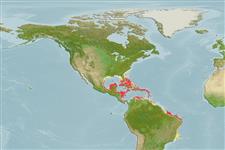Common names from other countries
>
Gobiiformes (Gobies) >
Gobiidae (Gobies) > Gobiinae
Etymology: Elacatinus: Greek, elakatines = fusiform fishes preserved in salt (Ref. 45335).
More on authors: Böhlke & Robins.
Environment: milieu / climate zone / depth range / distribution range
Ecologia
marinhas associadas(os) a recifes; intervalo de profundidade 1 - 53 m (Ref. 9710), usually 1 - 50 m (Ref. 27115). Tropical; 22°C - 27°C (Ref. 27115)
Western Atlantic: Bahamas and the Lesser Antilles to the northern coast of South America. Also Antilles and western Caribbean (Ref. 26938).
Tamanho / Peso / Idade
Maturity: Lm ? range ? - ? cm
Max length : 4.0 cm TL macho/indeterminado; (Ref. 26340)
Espinhos dorsais (total): 7; Raios dorsais moles (total): 12; Espinhos anais 1; Raios anais moles: 11 - 12. Yellow stripe in front of each eye, joining near tip of snout to form V. Mouth inferior; snout overhangs upper lip, connected by frenum (Ref. 26938). A black stripe beginning on snout, passing through lower part of eye, across upper end of gill opening onto body where it broadens and continues along lower side to end of caudal fin (Ref. 13442).
Inhabits coral reefs with clear waters, preferably in oceanic, insular areas (Ref. 13928). In pairs near coral heads. Monogamous (Ref. 52884). A cleaner (Ref. 9710). Minimum depth reported from Ref. 27115. Has been reared in captivity (Ref. 35420). Feeds on ectoparasites of fishes (Ref. 13442).
Life cycle and mating behavior
Maturidade | Reprodução | Desova | Ovos | Fecundidade | Larvas
Monogamous mating is observed as both obigate and social (Ref. 52884).
Böhlke, J.E. and C.C.G. Chaplin, 1993. Fishes of the Bahamas and adjacent tropical waters. 2nd edition. University of Texas Press, Austin. (Ref. 5521)
Categoria na Lista Vermelha da IUCN (Ref. 130435)
CITES (Ref. 128078)
Not Evaluated
Ameaça para o homem
Harmless
Utilização humana
Aquário: Espécies comerciais
Mais informação
ReferênciasAquaculturaPerfil para aquaculturaEstirpesGenéticaElectrophoresesHereditariedadeDoençasProcessamentoMass conversion
ColaboradoresFotografiasStamps, Coins Misc.SonsCiguateraVelocidadeTipo de nataçãoÁrea branquialOutras referênciasCérebrosVisão
Ferramentas
Relatórios especiais
Descarregue XML
Fontes da internet
Estimates based on models
Preferred temperature (Ref.
115969): 24.8 - 28, mean 27.3 (based on 360 cells).
Phylogenetic diversity index (Ref.
82804): PD
50 = 0.5000 [Uniqueness, from 0.5 = low to 2.0 = high].
Bayesian length-weight: a=0.00708 (0.00333 - 0.01504), b=3.09 (2.92 - 3.26), in cm Total Length, based on LWR estimates for this (Sub)family-body shape (Ref.
93245).
Nível Trófico (Ref.
69278): 3.4 ±0.35 se; based on food items.
Resiliência (Ref.
120179): Elevada, tempo mínimo de duplicação da população menor que 15 meses (Preliminary K or Fecundity.).
Fishing Vulnerability (Ref.
59153): Low vulnerability (10 of 100).
